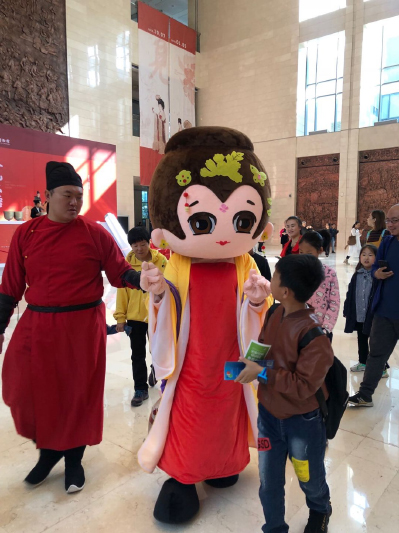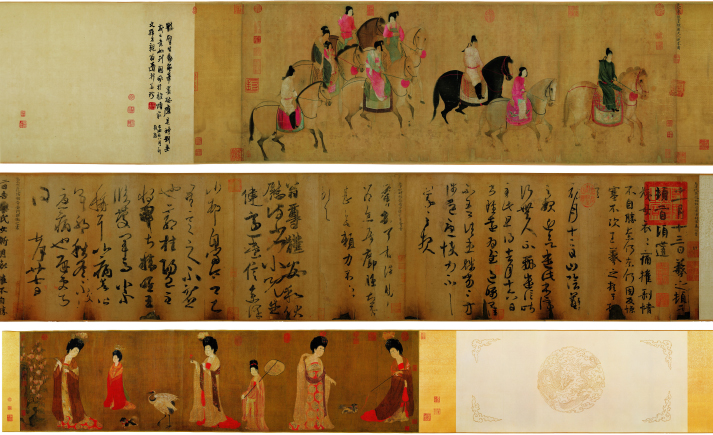| Lifestyle |
| Revitalizing History | |
| A calligraphy and painting exhibition brings the spirit of the Tang Dynasty civilization back | |
|
|
 The opening ceremony of the Meet the Tang Dynasty Again calligraphy and painting exhibition in the Liaoning Provincial Museum in Shenyang, capital of Liaoning Province in northeast China, on October 7 (DING YING)
Had the time machine been invented, the Tang Dynasty (618-907) would be a perfect choice for time travelers who want to experience history. It's a period full of energy, openness and creativity. Chang'an (today's Xi'an in Shaanxi Province in northwest China), the capital of the great empire, used to be an international metropolis. Merchants from different regions arrived with exotic goods; foreigners became officials and generals because of their extraordinary ability; and the most talented poets, singers, dancers, artists and craftspeople gathered there, creating a splendid civilization. Now history and culture buffs can get a closer glimpse of the Tang Dynasty without a time machine by visiting the Meet the Tang Dynasty Again calligraphy and painting exhibition in the Liaoning Provincial Museum in Shenyang City in northeast China. They will also discover the spirit of the Tang civilization, which was characterized by confidence, openness and inclusiveness. A feast of art Li Qi, a 34-year-old resident of Shenyang, capital of Liaoning Province, took her 7-year-old son to the museum on October 7, the last day of the National Day holidays. They waited in a long queue before the Calligraphy Models in Her Majestic Reign Year of Longevity to the Heaven, one of the most valuable exhibits. "Go through it slowly and thoroughly," she told the boy in a controlled low voice. "This is a Wang Xizhi calligraphy copied in the Tang Dynasty." Wang Xizhi, who lived 1,700 years ago, is regarded as the greatest calligrapher in Chinese history. And the Wang family has contributed the most outstanding calligraphers in different generations. Many Chinese emperors, including the only empress in Chinese history, Wu Zetian (624-705), were passionate about owning a genuine Wang calligraphy. So in 697, Wang's descendants parted with the precious collections of 28 calligraphers from nine generations of the family including Wang Xizhi to please the empress. The empress was delighted. However, she returned them to the family after getting the best calligrapher to copy them to provide models for the art. That is the story behind the Calligraphy Models. Li's son is learning calligraphy. She felt the exhibition was a very good opportunity for him to see the original work of great calligraphers. Normally, precious cultural relics like the Wang Xizhi scroll are carefully stored away for their protection. She told Beijing Review, "I know maybe it's impossible for him to understand all the beauty of these works, but I hope the exhibition can at least produce an aesthetic impression on him." The exhibition, co-hosted by the National Cultural Heritage Administration and the Publicity Department of the Liaoning Provincial Committee of the Communist Party of China, opened on October 7 and will continue till January 5, 2020. It presents visitors with a feast of art from the Tang Dynasty. Of the 100 exhibits, 38 are first-class national cultural relics. "The exhibition is an important platform to demonstrate Liaoning's profound culture in front of friends from home and overseas," Zhang Fuhai, head of the Publicity Department, said in his address at the opening ceremony of the exhibition on October 7. According to him, Liaoning has contributed its best artifacts to the exhibition. Among the 100 exhibits, 56 are from the Liaoning Provincial Museum. Some are well-known national treasures that people can see usually only in history books. The exhibition projects Liaoning's performance in the Tang Dynasty, Zhang said. "Marvelous!" applauded Wang Bangwei, Dean of the Institute of Oriental Studies, Peking University. "Even though I have been engaged in Tang history studies for decades, I never had a chance to see those renowned cultural relics. Today, my dream came true," he said at a forum on Tang Dynasty studies on October 7. Wang believes the exhibition will inspire academic researchers, while to ordinary people, it will bring priceless spiritual and cultural enjoyment.  A cartoon character and a museum staff member dressed in Tang period clothes catch the eye of a young visitor on October 7 (DING YING)
A brilliant period "The Tang Dynasty is an outstanding period in the 5,000-year Chinese civilization," Lu Cairong, Vice President of China International Publishing Group, said at the forum. The exhibition displays the outstanding traditional culture of China to the world, Lu said. Calligraphy and paintings are historical evidences of the flourishing Tang Dynasty. They represent the politics, culture, religion and other aspects of society and embody the most valuable cultural heritage and social memory of the Chinese people. "This is the first time in the world that the Tang Dynasty has been showcased through calligraphy and paintings," cultural studies scholar Liu Chuanming said. Liu is also the curator of the exhibition that has been complemented with other exhibits, such as statues, articles of daily use and gold items to depict the political, economic, cultural and artistic life during the Tang Dynasty, an age of vigor and dignified confidence with aesthetic characteristics. The exhibition hall recreates the atmosphere of the dynasty with the museum staff dressed in Tang period clothing. A giant landscape of Chang'an covers a wall while a girl plays the guqin, a traditional Chinese musical instrument with seven strings that has a history of over 3,000 years and was popular during the Tang Dynasty. Besides, the exhibition has also adopted hi-tech to create interactions between the exhibits and visitors. Through those interactive devices with audiovisual effects, visitors can see the prosperity that prevailed thousands of years ago and Chang'an's beautiful landscape and riverside scenery. They can step into people's life in that age and relive their experiences. "We hope visitors can have a real feel of the Tang Dynasty and be proud of our splendid civilization," Liu said.  A combination of priceless calligraphy and paintings from the exhibition (from top): Calligraphy Models in Her Majestic Reign Year of Longevity to the Heaven, Lady With Flower and Lady Waving a Fan and A Tour of Lady of Guo Kingdom in Spring (COURTESY PHOTO)
A cosmopolitan age Why was the Tang Dynasty a period of grandeur and prosperity? Ge Chengyong, a research fellow with the Chinese Academy of Cultural Heritage, believes the answer lies in the cosmopolitan culture of that age. The Tang empire attracted people from different countries with its openness, inclusiveness and prosperity, and influenced their development. It established an advanced administrative system that allowed foreigners to participate in it, which was rare at that time, Ge said at the forum. The period was also characterized by East-West cultural exchanges thanks to the ancient Silk Road. For example, Ge explained, gold coins from the Byzantine Empire and statues of camels have been excavated in Chaoyang, a city in west Liaoning, which used to be the easternmost territory of the Tang Dynasty. "The relics prove that Liaoning used to be a very important stop on the ancient Silk Road. In my view, Chaoyang in the Tang Dynasty was like today's Shenzhen, a frontier of foreign trade," he said. Shenzhen in south China's Guangdong Province is a hub of trade and industry. Wang agreed that it was the openness of the Tang Dynasty that enabled it to be so advanced socially and culturally. "We should never forget the cultural heritage of the Tang Dynasty. We should protect it and use it wisely to assist in today's national development and diplomatic relations," he said. Liu's conclusion was that the confidence, openness and tolerance of the Tang Dynasty are a necessity today, in China and in today's world. (Reporting from Shenyang, Liaoning Province) Copyedited by Sudeshna Sarkar Comments to dingying@bjreview.com |
|
||||||||||||||||||||||||||||
|